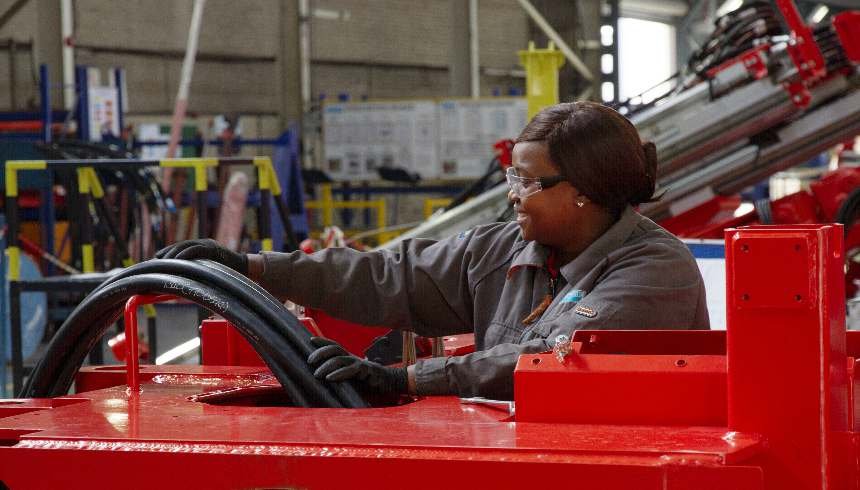Free Workshop Manager Course (6Months)
Workshop Manager:
Brief Job Description
A Workshop Manager is responsible for the overall management and service aspects of a workshop. The individual manages repair and maintenance of the vehicles in the workshop and also ensures proper functioning of workshop as per the guidelines of the OEM and manages workshop personnel..
Personal Attributes
An individual on this job must have good communication and interpersonal skills in addition to being a team player, as the job requires coordination with various internal and external stakeholders (like components dealers and field service manpower) to manage the workshop. The individual should have participative leadership skills to lead an effective team of technicians, supervisors and workshop support staff to motivate, train and provide overall work direction to the workshop staff. The individual must also have some financial knowledge to understand and monitor the overall profitability of the workshop. The individual should be systems and process oriented person to ensure various procedures and processes in the workshop.


Plan and organise work to meet expected outcomes:
Elements and Performance Criteria
Work requirements including various activities within the given time and set quality standards
To be competent, the user/individual on the job must be able to:
PC1. keep immediate work area clean and tidy
PC2. treat confidential information as per the organisations guidelines
PC3. work in line with organisations policies and procedures
PC4. work within the limits of job role
PC5. obtain guidance from appropriate people, where necessary
PC6. ensure work meets the agreed requirements
Appropriate use of resources
To be competent, the user/individual on the job must be able to:
PC7. establish and agree on work requirements with appropriate people
PC8. manage time, materials and cost effectively
PC9. use resources in a responsible manner
Knowledge and Understanding (KU)

The individual on the job needs to know and understand:
KU1. the organisations policies, procedures and priorities for area of work, role and responsibilities in carrying out that work
KU2. the limits of responsibilities and when to involve others
KU3. specific work requirements and who these must be agreed with
KU4. the importance of having a tidy work area and how to do this
KU5. how to prioritize workload according to urgency and importance and the benefits of this
KU6. the organisations policies and procedures for dealing with confidential information and the importance of complying with these
KU7. the purpose of keeping others updated with the progress of work
KU8. who to obtain guidance from and the typical circumstances when this may be required
KU9. the purpose and value of being flexible and adapting work plans
KU10. how to complete tasks accurately by following standard procedures
KU11. technical resources needed for work and how to obtain and use these
Generic Skills (GS)
User/individual on the job needs to know how to:
GS1. write in at least one language
GS2. read instructions, guidelines/procedures
GS3. ask for clarification and advice from appropriate persons
GS4. communicate orally with colleagues
GS5. make a decision on a suitable course of action appropriate for accurately completing the task within resources
GS6. agree objectives and work requirements
GS7. plan and organise work to achieve targets and deadlines
GS8. deliver consistent and reliable service to customers
GS9. check own work and ensure it meets customer requirements
GS10. anomalies to the concerned persons
GS11. analyse problems and identify work-arounds taking help from
GS12. apply own judgement to identify solutions in different situations
Work effectively in a team:

Elements and Performance Criteria
Effective communication
To be competent, the user/individual on the job must be able to:
PC1. maintain clear communication with colleagues
PC2. work with colleagues
PC3. pass on information to colleagues in line with organisational requirements
PC4.. work in ways that show respect for colleagues
PC5. carry out commitments made to colleagues
PC6. let colleagues know in good time if cannot carry out commitments, explaining the reasons
PC7. identify problems in working with colleagues and take the initiative to solve these problems
PC8. follow the organisations policies and procedures for working with colleagues
PC9. ability to share resources with other members as per priority of tasks
Knowledge and Understanding (KU)
The individual on the job needs to know and understand:
KU1. the organisations policies and procedures for working withcolleagues, role and responsibilities in relation to this
KU2. the importance of effective communication and establishing goodworking relationships with colleagues
KU3. different methods of communication and the circumstances inwhich it is appropriate to use these
KU4. benefits of developing productive working relationships withcolleagues
KU5. the importance of creating an environment of trust and mutualrespect
KU6. whether not meeting commitments, will have implications onindividuals and the organisation
KU7. different types of information that colleagues might need and theimportance of providing this information when it is required
KU8. the importance of problems, from colleagues perspective andhow to provide support, where necessary, to resolve these
Generic Skills (GS)
User/individual on the job needs to know how to:
GS1. complete well written work with attention to detail
GS2. read instructions, guidelines/procedures
GS3. listen effectively and orally communicate information
GS4. make decisions on a suitable course of action or response
GS5. plan and organise work to achieve targets and deadlines
GS6. check that the work meets customer requirements
GS7. deliver consistent and reliable service to customers
GS8. apply problem solving approaches in different situations
GS9. apply balanced judgements to different situations
GS10. apply good attention to detail
GS11. check that the work is complete and free from errors
GS12. get work checked by peers
GS13. work effectively in a team environment
Maintain a healthy,safe and secure working environment:

Elements and Performance Criteria
Resources needed to maintain a safe, secure working environment
To be competent, the user/individual on the job must be able to:
PC1. comply with organisations current health,safety and security policies and procedures
PC2. report any identified breaches in health,safety, and security policies and procedures to the designated person
PC3.. Coordinate with other resources at the workplace to achieve the healthy, safe and secure environment for all incorporating all government norms esp. for emergency situations like fires,earthquakes etc.
PC4. identify and correct any hazards like illness, accidents, fires or any other natural calamity safely and within the limits of individuals authority
PC5. report any hazards outside the individuals authority to the relevant person in line with organisational procedures and warn other people who may be affected
PC6. follow organisations emergency procedures for accidents, fires or any other natural calamity
PC7. identify and recommend opportunities for improving health,safety, and security to the designated person
PC8. complete all health and safety records are updates and procedures well defined
Knowledge and Understanding (KU)
The individual on the job needs to know and understand:
KU1. legislative requirements and organisations procedures for health, safety and security and individuals role and responsibilities in relation to this
KU2. what is meant by a hazard, including the different types of health and safety hazards that can be found in the workplace
KU3. how and when to report hazards
KU4. the limits of responsibility for dealing with hazards
KU5. the organisations emergency procedures for different emergency situations and the importance of following these
KU6. the importance of maintaining high standards of health, safety and security
KU7. implications that any non-compliance with health, safety and security may have on individuals and the organisation
KU8. different types of breaches in health, safety and security and how and when to report these
KU9. evacuation procedures for workers and visitors
KU10. how to summon medical assistance and the emergency services,where necessary
KU11. how to use the health, safety and accident reporting procedures and the importance of these
Generic Skills (GS)
User/individual on the job needs to know how to:
GS1. complete accurate, well written work with attention to detail
GS2. read instructions, guidelines/procedures/rules
GS3. listen and orally communicate information
GS4. make decisions on a suitable course of action or response
GS5. plan and organise work to achieve targets and deadlines
GS6. build and maintain positive and effective relationships withcolleagues and customers
GS7. apply problem solving approaches in different situations
GS8. analyse data and activities
GS9. apply balanced judgements to different situations
GS10. apply good attention to detail
GS11. check that the work is complete and free from errors
GS12. get work checked by peers
GS13. work effectively in a team environment

Manage customer relationship and quality service:
Elements and Performance Criteria
Manage the total customer satisfaction with enriching & pleasant customer experience
To be competent, the user/individual on the job must be able to:
PC1. . analyse and comprehend all customer requirements and needs
PC2. . document complete customer requisites and assess them
PC3. . deliver and assist in delivering as per the noted requirements
PC4. . understand complete customer queries and complaints
PC5. . document all customer queries in the prescribed format of the organisation PC6. ensure least turnaround time for any customer query handling/redressal especially issues related to warranty claims and other performance related issues
PC6.. ensure least turnaround time for any customer query handling/redressal especially issues related to warranty claims and other performance related issues
PC7. . maximise customer satisfaction through pleasant and excellent customer experience within the organisations framework
PC8. . document feedbacks and reviews from the customers & implement within the framework of the organization
PC9. . maintain a healthy & professional relationship with the customers especially key accounts and influencers in the market
Knowledge and Understanding (KU)
The individual on the job needs to know and understand:
KU1. standard operating procedures within ones own organisation
KU2. standard operating procedures for query and complaint reporting along with their redressal mechanism in the organisation
KU3. framework and guidelines as prescribed by the organisation for query and complaint redressal
KU4. customer Relationship Management (CRM) related framework provided by the organisation
KU5. terms & conditions agreed between the respective auto component/ aggregate and the various OEMs/ OEM channel partners for supply, procurement of the various auto components/ aggregates
KU6. documentation requirements for each procedure carried out as part of roles and responsibilities as per the organizational guidelines
KU7. organisational and professional code of ethics and standards of practice
KU8. safety and health policies and regulations for the workplace
KU9. the technical specifications of various OEM vehicles and the different variant/ model of auto components/ aggregates used along with those of the competitor auto component manufacturer
KU10. detailed technical and performance specifications of the auto component for various OEM vehicles
KU11. how to collaborate with the organizational manufacturing engineering, product management teams along with the service team of the respective OEM vehicle and local channel partner service team
KU12. documentation requirements from the customers with respect to warranty claims and other performance related feedback on the for respective OEM vehicle
KU13. requirements of the customers and suggest delivery accordingly
KU14. software or format such as MS word, excel, PowerPoint and Management Information System (MIS)
KU15. software or format used to capture for Customer Relationship Management (CRM) within the organisation
KU16. how to capture customer voice/ feedback on the auto components/ aggregates for various OEM vehicles on price, performance, availability of spares, warranty & other service-related aspects etc.
Generic Skills (GS)
User/individual on the job needs to know how to:
GS1. create documents required on the job (including database on key customers/ accounts and major retailers, response or feedback forms, customer-query sheets, response or feedback sheets etc.)
GS2. either write or get it done from subordinates, a detailed failure report analysis in case of a failed component/ aggregate escalating to the auto component manufacturer
GS3. write in at least one language
GS4. read feedback from customers on warranty and other performance related aspects
GS5. read the specific requirements, queries that the customer may have on various auto components including any specific technical query
GS6. read brochures and technical specifications of the vehicle provided by the OEM and channel partner (Dealership)
GS7. read policies and regulations pertinent to the job
GS8. interact with the customers for getting their requirements, queries and feedbacks
GS9. interact with organisations internal stakeholders for efficient customer relationship management interact with team members to work efficiently
GS10. analyse information and evaluate results to choose the best solution and solve problems
GS11. analyse any potential issue that may affect the performance of the vehicle and convey it in a timely manner
GS12. plan work assigned on a daily basis
GS13. follow up regularly on potential complaints, issues raised by the customer
GS14. ensure that customer needs are assessed and satisfactory service is provided
GS15. ensure that performance of the auto component is up to the mark and any pending issues or complaints are resolved in a timely manner according to the terms & conditions mandated by either the OEM or the auto component manufacturer
GS16. analyse all the complaints, queries or issues raised by the customers to either the OEM channel partner/ auto component dealer/ retailer in the market
GS17. deliver and act as per the organisation provided/guided resolutions
GS18. liaise with all stakeholders to ensure hassle-free resolution of the complaints by the concerned customer in a timely fashion
GS19. evaluate and identify areas of complaints from the customer affecting the performance of his vehicle
GS20. assess time and cost required for customer resolution based on complaints, problems or queries identified
GS21. evaluate and identify key customer experience enhancing areas
GS22. evaluate the information gathered from the customer complaint report and utilise it to identify timely resolutions
GS23. evaluate the information gathered from the market (including retail segment, key accounts/ customers and OEM along with the OEM channel partners) and use it to ensure higher customer satisfaction
Supervise and evaluate performance:
Elements and Performance Criteria
Supervise & evaluate performance of all subordinates and reporting executives
To be competent, the user/individual on the job must be able to:
PC1.. set goals and targets as per organisational directives for all reporting executives
PC2.. create quantified measures and metrics to analyse the performance deliveredby subordinates
PC3.. set tangible and achievable incentives for subordinates as per the goals andtargets assigned
PC4.. ensure and implement strict adherence of all activities performed bysubordinates to organisational guidelines
PC5.. monitor and supervise all the activities performed by subordinates and ensureoptimisation to achieve the set goals
PC6. evaluate performance of subordinates and reporting executives on thedesigned measures and metrics as per the guidelines of the Ogranization
PC7.. assist and support reporting executives whenever necessary or applicable
PC8.. document all performance indicators and metrics of subordinates in theprescribed format of organisation
PC9.. perform all appraisal related process flow for subordinates, as per respectiveperformance documents
PC10. handover all the documents and appropriate support measures to humanresources department for official records
PC11. ensure and implement proper process flow for feedbacks and queries receivedfrom subordinates
Knowledge and Understanding (KU)
The individual on the job needs to know and understand:
KU1. standard operating procedures of the organisation for appraisals, incentives, promotions and performance evaluation
KU2. operating procedures for query and problem reporting and their redressal in the organisation
KU3. framework and guidelines prescribed by the organisation for query and problem redressal
KU4. framework and guidelines prescribed by the organisation for performance evaluations and based appraisals out of it
KU5. documentation requirements for each procedure carried out as part of roles and responsibilities
KU6. institutional and professional code of ethics and standards of practice
KU7. safety and health policies and regulations for the workplace
KU8. documentation requirements for appraisals and other performance evaluations of various subordinate positions
KU9. process flow for performance evaluation, documentation and appraisals related with them
KU10. subordinate and reporting executives problems and queries and documenting it in the organisations prescribed format
KU11. redressal documentations mechanisms available in the organization and actingaccordingly in a timely manner
KU12. software or Format such as MS Word, Excel, PowerPoint and Management Information System (MIS) as prescribed by the organization
Generic Skills (GS)
User/individual on the job needs to know how to:
GS1. communicate information and ideas in writing so that the subordinates andpeers can understand
GS2. create documents required on the job (including requirement sheets, querysheets, response or feedback sheets etc.)
GS3. write at least one local language
GS4. read reviews from subordinates in terms of their requirements, queries andfeedbacks
GS5. read appraisal documents related with any of subordinating position
GS6. read policies and regulations pertinent to the job
GS7. interact with all subordinates to understanding their requirements, queries and feedbacks on various aspects within the organisation
GS8. interact with organisations internal stakeholders to ensure efficient performance evaluation of the subordinates leading to higher levels of satisfaction and motivation
GS9. analyse information and evaluate results amongst the various available options or metrics on the performance indicators to choose best way to motivate subordinates through: rewards and recognition schemes promotion transfer to other work stream nominate for an executive training any other monetary or non-monetary benefits
GS10. plan work on a daily basisto ensure higher levels of motivated within the teamsupervising wherever required and giving freedom and independence to thesubordinates to ensure high quality work output with minimum superiorguidance leading to holistic development of the subordinate
GS11. ensure all activities performed by subordinates and reporting executives is in sync with broader organisational goals to ensure higher customer satisfaction
GS12. analyse all the queries or problems posted by subordinates and find an appropriate solution acceptable to the subordinates
GS13. deliver and act as per the organisation provided/guided resolutions
GS14. evaluate and identify all key requirements of the subordinates and try to solvevarious issues to ensure higher motivational levels
GS15. assess additional cost burden as a result of various incentives schemes and other rewards & recognition schemes for the subordinates and take an optimum decision to ensure the overall profitability of the organisation
GS16. assess additional cost burden as a result of various incentives schemes and other rewards & recognition schemes for the subordinates and take an optimum decision to ensure the overall profitability of the organisation
Manage workshop operations:
Elements and Performance Criteria
Manage overall workshop operations and ensure implementation of proper systems
To be competent, the user/individual on the job must be able to:
PC1.. monitor overall workshop operations related to service, maintenance and repair of vehicles
PC2. . manage the workshop personnel across various level (including mechanic and back office team) keeping the overall volume of vehicles and financial profitability in mind as per the OEM guidelines: identify manpower gaps amongst the mechanics and other back office staff (including spare parts, service advisors, warranty etc.) for various workshop bays recruit trained workshop personnel that is competent enough to carry out the overall service and repair process of the vehicles as per the OEM guidelines allocate the supervisors/ service advisors/ mechanics/ technical specialist across the various bays in the workshop timely communication of incentive schemes and ensure proper distribution of the rewards / incentives to maintain higher levels of motivation amongst the workshop manpower
PC3. . evaluate performance of Workshop personnel and ensure proper training needs are assessed for existing employees & actual training for the newly recruited manpower as specified by the OEM specific technical training especially on the new technologies required for the workshop manpower and nominate people to attend those trainings (like CNG, BS-3 engines etc.) proper identification of workshop manpower to attend trainings on service and repair aspects of newly launched vehicles or any other product refresh as introduced by the OEM periodically
PC4. . Ensure discipline and adherence of personnel to organisations regulations
PC5.. manage day to day trouble-shooting as a result of adverse performance of vehicles due to various components/ aggregates or any other escalation done by the customers
PC6. . ensure that service, repair and maintenance of the vehicles is done in a timely manner and within the cost estimates as per the OEM guidelines
PC7. . monitor faults, failure of the respective auto component/ aggregate and escalate the technical fault to the concerned person
PC8. . provide personnel protective equipment to all people working on the bays of the workshop to promote a safe working environment
PC9. . manage the maintenance of workshop facilities and other tools including fixed equipment
PC10. . ensure full optimised utilisation of manpower and resources to achieve planned revenue and profitability targets for the Workshop through both direct service & repairs as well as non-vehicular sales (including spares& lube/ aggregates, reconditioned aggregates and annual maintenance contracts)
PC11.. ensure quality of workmanship in all service, repair and maintenance and other workshop operations carried out
PC12. . ensure availability of spare parts, lubricants and other materials as per the requirements of the Workshop
PC13.. select right tools (including various special tools) /equipment/machinery needed for the Workshop as per the mandated OEM guidelines
PC14.. liaise with internal and external stakeholders to ensure smooth functioning of workshop
PC15.. report to the superiors on overall functioning of the Workshop and on any requirements/ challenges/ problems faced which needs his attention
PC16.. liaison with OEMs, vendors including field staff for auto -components/ aggregate suppliers and other external stakeholders to ensure smooth functioning of workshop and help in early resolution of pending issues pertaining to the service and maintenance or performance related aspects of the vehicle
Knowledge and Understanding (KU)
The individual on the job needs to know and understand:
KU1. standard operating procedures of the Organisation/ Dealership for inspection, maintenance, servicing and repair of vehicles
KU2. standard operating procedures for servicing, repair and replacement of various auto parts/ aggregates mandated by the OEM
KU3. safety requirements for equipment and auto-components/ aggregates as prescribed by the OEM
KU4. documentation requirements for each procedure carried out as part of roles and responsibilities regarding the service, maintenance and repair across various job roles in a workshop as specified by the respective OEM
KU5. Organisational and professional code of ethics and standards of practice
KU6. safety and health policies and regulations for the workplace as well as for automotive trade in general (e.g. safe practices while working in pits/ under
KU7. the technical specifications of various OEM vehicular products as well as those manufactured by the competitors
KU8. the basic technology used in the overall functioning of various components/ aggregates (especially the core aggregates like engine, gear box, propeller shaft, clutch and brake assembly, transmission systems, axles etc.)
KU9. how to train and provide guidance (both technical and soft skills) to the workshop employees and staff in all matters relating to the overall automotive service, maintenance and repair of OEM vehicles
KU10. the technical aspects communicated from Service, Product planning or Quality control, R&D departments of the OEM (through various service circulars) are communicated to the workshop team though regular meetings to ensure proper adherence
KU11. various aspects of retro-fitments to be specified batch of vehicles as indicated by service or production and planning department of the OEM
KU12. Purchase orders, invoices, job cards, feedback forms or any other service related documents as specified by the respective OEM
KU13. how to check and regularly monitor all tools and equipment for efficient use& ensure timely calibration of the various tools &equipments as specified by the tool manufacturer
KU14. how to maintain manuals on vehicles repair and service and communicate the technical information to the workshop manpower
KU15. the plan and process required to carry out preventive maintenance schedules for workshop tools and equipment
KU16. how to liaise with suppliers to manage and ensure warranties and service guidelines
KU17. how to advice staff to deal with customers on various technical issues contributing to adverse vehicle performance in a professional manner to ensure customer satisfaction
KU18. how to create regular reports on service and workshop performance basis the vehicles attended by the workshop
Generic Skills (GS)
User/individual on the job needs to know how to:
GS1. communicate information and ideas in writing so others will understand
GS2. prepare all diagnostic and repair reports of various components/ aggregates in a vehicle along with the detailed failure or complaint investigation reports
GS3. prepare the overall profitability report for the workshop including the vehicle inflow, spare parts consumption and the strategy highlighting the way forward to increase the overall profitability
GS4. write in at least one language
GS5. read the reports and details mentioned on the job card, technician notes and warranty schemes
GS6. read and understand various service &maintenance circulars issued by the OEM/ auto- components manufacturer
GS7. interact with the customers in a professional and courteous manner even for the irate customers
GS8. interact with various stakeholders (including OEM, auto components field service manpower or any other external agency) regarding warranty decision and other service and routine maintenance of the vehicles
GS9. interact with team members to work efficiently
GS10. decide the training needs (especially on technical aspects of new product introduction, existing product refreshes or any new technologies like CNG, BS3/4 etc.) required to improve the workshop personnel performance
GS11. decide the optimised process at the workshop to ensure smooth operations
GS12. analyse all options available regarding repair or replacement of the various aggregates/ components in a vehicles post diagnostic of the fault
GS13. plan work according to the required schedule and location
GS14. plan the daily operations at the workshop in the morning to ensure the smooth flow of service & maintenance of the vehicles
GS15. ensure that service provided is of the highest order to ensure higher levels of customer satisfaction
GS16. ensure proper terms& conditions are conveyed to the targeted customer purchasing reconditioned aggregates or Annual Maintenance Contracts (Non – vehicular sales) to ensure higher customer satisfaction
GS17. ensure proper attention to off-road breakdown vehicle
GS18. identify complex problems and reviewing related information to develop and evaluate options and implement solutions
GS19. determine the critical problems that need urgent action
GS20. determine the appropriate action needed for the off-road breakdown vehicles to ensure timely attention is provided and vehicles is put on-road quickly
GS21. develop solutions for identified faults and issues in the various components/ aggregates of the vehicle and ensure that the necessary corrective action is performed in timely & cost effective manner
GS22. liaison with OEM Sales support or auto-component field service functions to ensure proper arrangements and documentation as mandated by the OEM
GS23. analyse available information and evaluate results to identify the best solution available for the particular fault
GS24. evaluate the complexity of tasks to be performed in the workshop to determine its feasibility with respect to cost and time taken
GS25. use logic and reasoning to identify the strengths and weaknesses of alternative solutions, conclusions or approaches to problems
GS26. evaluate the information gathered from the job card/ technician notes, warranty claims and maintenance details and take appropriate action to ensure maximum customer satisfaction with overall performance of the vehicle
Liaise with other stakeholders for complaint resolution:
Elements and Performance Criteria
Liaison with other stakeholders for failure analysis and complaint resolution
To be competent, the user/individual on the job must be able to:
PC1. . establish smooth system for gathering technical information from the field as well the competitors using the same components/ aggregates
PC2. . obtain sufficient information from the job card to understand the potential reason of the fault in the vehicle before communicating it to external stakeholders
PC3. . identify routine technical issues with the ancillary suppliers (including those supplying Fuel Injection Pumps, tyres, injectors, propeller shafts, axles, clutch and brake assembly or any other electrical equipment like horn, alternator, wiring harness etc.)
PC4.. establish good contacts with the various external stakeholders in quick resolution of the technical issues faced by the customer
PC5. . inform OEM product development & service team / auto-component field team about technical and performance issues arising in the area
PC6. . handle customer complaints regarding product and escalate it concerned person in the OEM/ Component manufacturer through a detailed CIR (Complaint Investigation Report)
PC7. . manage the availability of spare parts through OEM or auto-components spare distributors
PC8.. handle problems related to break down of vehicles outside the premises of the workshop and ensure quick resolution of the issues so that the vehicle can be put on road quickly
Knowledge and Understanding (KU)
The individual on the job needs to know and understand:
KU1. standard operating procedures for service, repair and replacement of vehicles according to the mandated terms and conditions
KU2. standard operating procedures for servicing, repair and replacement of parts mandated by the OEM including the warranty terms & conditions of variousaggregates/auto components
KU3. safety requirements for equipment and components/ aggregates as prescribed by the OEM
KU4. documentation requirements for each procedure carried out as part of roles and responsibilities
KU5. institutional and professional code of ethics and standards of practice
KU6. safety and health policies and regulations for the workplace as well as for automotive trade in general (e.g. safe practices while working in pits/ under vehicles)
KU7. the required technical information on various components/ aggregates
KU8. warranty policies and terms and conditions for various aggregates/ components and communicate that to the customer along with escalation to superior authorities in case of any disagreement
KU9. the technical problems related with a particular breakdown situation and required procedures to bring the vehicle on-road quickly
KU10. the fault correction diagnosis and refer to the correct person for repair or replacement
KU11. how to manage availability of key spare parts, other accessories and vital components in case of urgent requirement for repair/ maintenance of the vehicle
KU12. how to liaise and coordinate with automotive spare parts manager, sales function and the manufacturing plant for the specific vehicles or auto component/ aggregate
KU13. the resolution/ redress mechanism for the technical issues pertaining to repeated customer complaints on the vehicle or any specific component/ aggregate
KU14. how to monitor product performance against the competitor, gather feedbacks and convey them to the concerned external agencies
Generic Skills (GS)
User/individual on the job needs to know how to:
GS1. complete and maintain workplace records
GS2. record all diagnostic inspections and tests carried out on a vehicle
GS3. convert the investigation/ diagnostics into a report that can be escalated to the OEM/ auto component manufacturer
GS4. read and interpret workplace related documentation
GS5. read and understand the various warranty manuals and terms & conditions for components/ aggregates as specified by their manufacturer
GS6. clearly communicate workplace information and ideas with workplace colleagues (verbal and non-verbal), including use of automotive terms
GS7. use terms, names, grades, and other nomenclature pertaining to the automotive trade, tools, specific workshop equipment etc.
GS8. communicate with colleagues and customers to handle verbal enquiries, such as clarifying instructions and responding to requests for information
GS9. determine the nature and objective of the analysis and evaluation required and decide on the diagnostic techniques to be applied as mandated by the external stakeholders like component manufacturer
GS10. decide the nature of the complaint and proper escalation mechanism as mandated by organisational guidelines
GS11. plan work assigned on a daily basis and provide estimates of time required for each piece of work
GS12. prioritise actions to achieve required outcomes
GS13. interpret the needs of customers by evaluating job cards and talking to external stakeholders like auto component/ aggregate distributors and field service manpower
GS14. ensure that any major faults arising out of poor maintenance of the vehicle is conveyed to the customer (especially in case of non-adherence to terms & conditions which may lead to rejection of warranty)
GS15. ensure that customer needs are assessed and in case of rejection of warranty by the ancillary suppliers, build up a proper case for claim to be processed under goodwill gesture (technical or commercial)
GS16. escalate the complex failure reports to the superior authority
GS17. gather information and diagnosis results to provide assistance to solve problems facing the customer
GS18. liaise to get the issues/ problems of the customer solved in a time bound manner
GS19. ensure practical and cost-effective diagnosis to common off-road breakdowns reported by the vehicles outside the workshop within the OEM/ manufacturers
GS20. analyse the complexity of faults/ problems to determine the level of escalation required to the external stakeholders including components/ aggregate distributor/ component field force manpower/ OEM service manpower
GS21. analyse, evaluate and apply the information gathered from observation, experience, reasoning, or communication to act efficiently
GS22. critically observe various symptoms affecting the performance of the vehicle & convey the findings of the root cause to the concerned authorities for quick resolution of the issue
Assessment Guidelines:
- Criteria for assessment for each Qualification Pack will be created by the Sector Skill Council. Each Element/ Performance Criteria (PC) will be assigned marks proportional to its importance in NOS. SSC will also lay down proportion of marks for Theory and Skills Practical for each Element/ PC.
- The assessment for the theory part will be based on knowledge bank of questions created by the SSC.
- Assessment will be conducted for all compulsory NOS, and where applicable, on the selected elective/option NOS/set of NOS.
- Individual assessment agencies will create unique question papers for theory part for each candidate at each examination/training center (as per assessment criteria below).
- Individual assessment agencies will create unique evaluations for skill practical for every student at each examination/ training center based on these criteria.
- To pass the Qualification Pack assessment, every trainee should score the Recommended Pass % aggregate for the QP.
In case of unsuccessful completion, the trainee may seek reassessment on the Qualification Pack.









